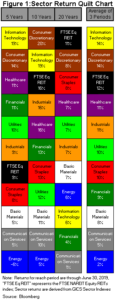Clearing Up the REIT Misperceptions of Generalist Investors | December 2019
December 1, 2019
After attending November’s NAREIT Conference in Los Angeles, we returned with a wealth of new ideas, information, and perspectives gleaned from management teams and our fellow investors. It also reminded us how much the industry and its investor base have evolved over the past several decades. Specifically, investors that are not dedicated to any particular market sector, known as generalists, have increased their share of REIT equity from 11% in 2Q12 to 27% as of 2Q19, according to Citi Research. While we are appreciative of the increase, the average generalist fund is still 58% underweight to REITs relative to its benchmark as of 3/25/19, according to Green Street Advisors.
We believe some of the most popular misconceptions causing some generalists to ignore active management of REITs are: 1) lower potential returns relative to other sectors, 2) interest rate sensitivity, 3) volatility, 4) lack of differentiation allows for passive management, 5) underestimating durability of cash flows, and 6) unfamiliar nomenclature.
REITS Offer Compelling Returns
One of generalists’ misperceptions about REITs is that the returns are unimpressive relative to other risk assets. When looking at the data in “quilt chart” in Figure 1, it is evident that this perception is not reality. REITs have had compelling returns as they have climbed the figurative “Wall of Worry”, which might need to be renamed “Wall of Misunderstanding”. Counterintuitively, the current underweight by generalists translates to an opportunity for further outperformance as adoption increases. Therefore, despite the MSCI US REIT Index’s (RMZ) +26.7% total return year to date as of 11/30/19 and the historical outperformance, we believe REIT valuations are nowhere near the “euphoria” state that typically precludes a correction.
Interest Rates Have Low Long Term Correlation with REITs
Even when generalists appreciate REIT performance, it is often attributed to declining interest rates. The consensus among these generalists is that REIT performance should be negatively correlated to the 10 yr US Treasury yield. Therefore, many who thought interest rates would rise have avoided REITs.
However, as shown in Figure 2, REITs produced a positive total return on average during the 11 periods of rising interest rates since 1996. In addition, although REITs underperformed the S&P 500 during these periods on average, they recouped the underperformance when interest rates stopped rising. Moreover, REIT investors did not have to wait long to recapture this underperformance as most (if not all) of it was recovered in the subsequent 90, 180, and 365 days.

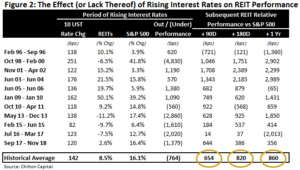
Furthermore, as can be surmised from the positive performance during rising interest rates, there has not been a strong negative correlation between REIT performance and interest rates. In past 10, 20, and 30 year periods, the correlation between monthly REIT returns and 10 yr US Treasury returns has been 0.08, -0.06, and 0.02, respectively, which indicates little to no relationship. Admittedly, there were some short term periods of strong negative correlation, but we believe the long term trends are most important for making investment decisions.
Finally, the ‘experts’ have been overwhelmingly terrible at predicting interest rate movements. As shown in Figure 3, the Federal Reserve’s quarterly survey of professional forecasters of 10 yr Treasury yields did not prove adequately clairvoyant for a profit-seeking investor. In fact, the consensus called for rising interest rates in every year since 2004, which obviously did not pan out. In contrast to basing a potential investment in REITs on a consensus view of interest rate forecasts, we suggest generalists construct (or outsource) a bottom-up portfolio of undervalued businesses run by management teams with superior capital allocation ability and properties with competitive advantages.

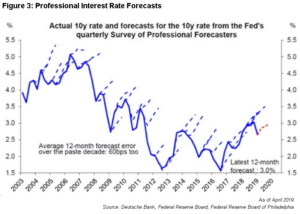
Volatility Is Not That Big of a Deal
Some investors may have been deterred from REITs due to the relatively high volatility (as measured by standard deviation) of REIT performance, particularly in 2008-2009. For instance, the Chilton REIT Composite’s standard deviation since inception is 21.3% relative to the S&P 500’s 13.9%. However, we believe standard deviation is just one of several ways to measure risk. We also look at rolling returns to smooth out daily, weekly, and monthly volatility that is not relevant for a long term investor. As shown in Figure 4, the 10 year returns of REITs since the index began in 1972 have been remarkably consistent, especially when compared to the S&P 500. Assuming REIT investors held their investment through the entire time period, there was there not a single 10 year period where they would have lost money. As a matter of fact, in the worst ten year period, they would have actually made at least a 2.5% annualized return. When looking at the S&P 500, it endured over 20 rolling periods of negative annualized 10 year returns. As such, an investor that is willing to hold an investment for 10 years should consider REITs as less risky than the S&P.

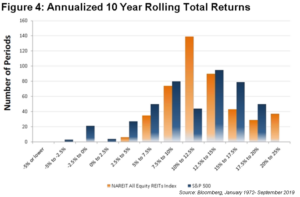
Differentiated REIT Business Models Can Produce Outperformance for Active Managers
Another common opinion that investors outside the REIT industry express is that they are largely a commodity that can be owned simply through an exchange traded fund (ETF). According to data provided by Citi Research, an estimated 27% of REITs are owned by generalists as of 2Q19. This generalist ownership is comprised of over 60% passively managed mutual funds or ETFs. That is the generalists’ way of saying, “just give me broad exposure to REITs because they’re all the same or because it’s too small in the benchmark to make a difference in my performance”. However, when looking more closely at the space, an investor will see that REITs are not just a collection of properties. Similar to the global equity market and the economy at large, there are superior and inferior businesses and management teams within the REIT space.
The heterogeneous mix of business models, competitive advantages, management teams, and capital allocation strategies have compounded shareholder returns to varying degrees over the long term. And, perhaps precisely because of the lack of worldwide appreciation for REITs, there are consistent mispricing arbitrage opportunities available for active managers willing to perform the proper due diligence. The aforementioned differentiation between individual REITs as well as REIT sectors has enabled Chilton’s concentrated REIT strategy to outperform its benchmark over the long term.
Cash Flow Durability Commands Higher Valuation Multiples
Generalist investors accustomed to analyzing companies outside the REIT space tend to underestimate the durability of REIT cash flows. A small minority of companies in the broader economy have the level of contractual cash flow streams that landlords have. The percentage of leases that expire and are renewed annually as a percentage of revenue are relatively low depending on the property type, but the end result is a weighted average contract that is much longer than a typical S&P 500 company. In addition, the contractual nature of leases gives management teams time and visibility to address problematic or weak tenants. The contracts can be broken, but they carry significant termination fees which serve as an excellent deterrent for early terminations. For example, Tesla (NASDAQ: TSLA) CEO Elon Musk tweeted his intent to get rid of the Tesla brick-and-mortar stores in February 2019, but later had to retract when learning of the financial ramifications of terminating the current leases. It is no mystery why most businesses look to rent expense as a last resort to reduce their cost structure.
The long term nature of leases and robust disclosures allow investors and analysts to more accurately predict future REIT earnings relative to S&P 500 companies, as shown in Figure 5. The blue and red lines show the magnitude of the difference between actual reported earnings growth and analysts’ expected growth. The S&P 500’s actual growth, in blue, averaged approximately 9.8% below consensus estimates while actual REIT FFO growth averaged 0.1% above Citi’s estimates.

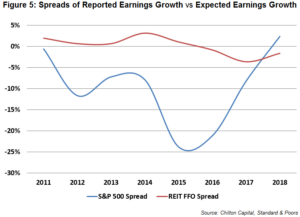
The high predictability of REIT earnings streams translates to a lower discount rate, or a higher multiple, on current cash flow. Furthermore, the lower discount rate should also apply to the terminal value, which is also often underestimated by generalists due to the fear of obsolescence. However, we believe that an astute management team with well-located properties will maintain, enhance, and sometimes reposition properties to maximize value in spite of changing trends. As an example, the retail industry is going through significant change with the emergence of e-commerce over the past couple of decades. While this technological disruption has made some business models obsolete, REITs have the ability to adapt their assets and strategy to the current and future needs of retail consumers and retailers. Simon Property Group (NYSE: SPG) shares only 1 tenant in its top 10 tenants by annualized revenue between 1993 and 2019, but the stock produced an annualized total return of 14% over that nearly 26 year period.
GFC: A Major Lesson Learned
Because we are in the same economic cycle that began in the depths of the Great Financial Crisis (GFC), many investors are still left with a bad taste in their mouth for real estate. While there were many parties that played a role in the last downturn, single family real estate severely impaired the function of the capital markets and the broader economy in 2008-2009. One of the consequences of these experiences is that real estate owners, even those outside of the single-family housing sector, are painted with a broad brush to be speculators that leverage up on the next project. While we can not say with as much confidence what the private real estate sector is doing this cycle, the more transparent, publicly traded side is well capitalized and behaving very prudently. REIT leverage has been essentially cut in half, dividends enjoy record coverage by cash flow, and external growth is often funded with free cash flow. As a result, the net debt to EBITDA of REITs is 5.4x as of 9/30/19, which compares to 13.8x as of 12/31/06, which preceded the recession.
GAAP Accounting is Bad News for REITs
Another generalist misunderstanding of the REIT sector is accounting. As the language of business, accounting plays an important role in understanding a business’ economics and ultimately appraising it. Generalists tend to look at a very broad array of measures to assess the underlying earnings power of a company. These include but are not limited to discounted cash flow analysis, enterprise value (EV) to sales, EV to EBITDA (earnings before interest, taxes, depreciation, and amortization), EV to free cash flow, price to earnings, price to book, comparable valuation to its peers, and precedent transactions in public and private markets. However astute and effective these measures can be in some sectors, each one is different and real estate is no exception. We have found that using some of the common metrics above will ultimately prove ineffective in valuing REITs accurately.
Proper equity REIT valuation metrics are based on cash flow, which means that GAAP metrics such as P/E, EPS, and P/B should be ignored. However, we consistently see misleading data from business reporting services that try to make REITs fit into the “GAAP box”. For example, potential investors are regularly shocked when looking at the relatively high P/E ratios of REITs because they are not aware that REIT net income is severely penalized by depreciation, which is a non-cash charge.
Misperception Creates Opportunity
The list of misperceptions above is by no means exhaustive but merely the ones we find most prevalent. Alone, they would provide a plethora of attractively mispriced investment opportunities. However, when combined with irrationality produced by investor fear and greed, it broadens our menu of prospective investments even more. As generalists overcome these misperceptions in time, the REIT market will become more efficiently and abundantly capitalized. At that point, we will still have investor emotion to provide us with mispricing and opportunity in the market. If there is one thing we can confidently predict, it is that human emotion is not going away anytime soon. In the meantime, we will continue to seize the investment returns yielded by both.
Richard J. Pickert, CFA
rpickert@chiltonreit.com
(713) 243-3211
Matthew R. Werner, CFA
mwerner@chiltonreit.com
(713) 243-3234
Bruce G. Garrison, CFA
bgarrison@chiltonreit.com
(713) 243-3233
RMS: 2418 (11.30.2019) vs 1909 (12.31.2018) vs 346 (3.6.2009) and 1330 (2.7.2007)
Previous editions of the Chilton Capital REIT Outlook are available at www.chiltonreit.com/category/library/reit-outlook/.
An investment cannot be made directly in an index. The funds consist of securities which vary significantly from those in the benchmark indexes listed above and performance calculation methods may not be entirely comparable. Accordingly, comparing results shown to those of such indexes may be of limited use.
The information contained herein should be considered to be current only as of the date indicated, and we do not undertake any obligation to update the information contained herein in light of later circumstances or events. This publication may contain forward looking statements and projections that are based on the current beliefs and assumptions of Chilton Capital Management and on information currently available that we believe to be reasonable, however, such statements necessarily involve risks, uncertainties and assumptions, and prospective investors may not put undue reliance on any of these statements. This communication is provided for informational purposes only and does not constitute an offer or a solicitation to buy, hold, or sell an interest in any Chilton investment or any other security.
for more info on our strategy
go now →
for more info on our strategy
go now →
VIEW CHILTON'S LATEST
Media Features
go now →
Contact Us
READ THE LATEST
REIT Outlook
go now →
disclaimers
terms & conditions & FORM ADV
SITE CREDIT
Navigate
HOME
TEAM
REITS 101
Approach
OUTLOOKS
media
Contact
back to top
VISIT CHILTON CAPITAL MANAGEMENT
This property and any marketing on the property are provided by Chilton Capital Management, LLC and their affiliates (together, "Chilton"). Investment advisory services are provided by Chilton, an investment adviser registered with the SEC. Please be aware that registration with the SEC does not in any way constitute an endorsement by the SEC of an investment adviser’s skill or expertise. Further, registration does not imply or guarantee that a registered adviser has achieved a certain level of skill, competency, sophistication, expertise or training in providing advisory services to its advisory clients. Please consider your objectives before investing. A diversified portfolio does not ensure a profit or protect against a loss. Past performance does not guarantee future results. Investment outcomes, simulations, and projections are forward-looking statements and hypothetical in nature. Neither this website nor any of its contents shall constitute an offer, solicitation, or advice to buy or sell securities in any jurisdictions where Chilton is not registered. Any information provided prior to opening an advisory account is on the basis that it will not constitute investment advice and that we are not a fiduciary to any person by reason of providing such information. Any descriptions involving investment process, portfolio construction or characteristics, investment strategies, research methodology or analysis, statistical analysis, goals, risk management are preliminary, provided for illustration purposes only, and are not complete and will not apply in all situations. The content herein may be changed at any time in our discretion . Performance targets or objectives should not be relied upon as an indication of actual or projected future performance. Investment products and investments in securities are: NOT FDIC INSURED • NOT A DEPOSIT OR OTHER OBLIGATION OF,OR GUARANTEED BY A BANK • SUBJECT TO INVESTMENT RISKS, INCLUDING POSSIBLE LOSS OF THE PRINCIPAL AMOUNT INVESTED. Investing in securities involves risks, and there is always the potential of losing money when you invest in securities including possible loss of the principal amount invested. Before investing, consider your investment objectives and our fees and expenses. Our advisory services are designed to assist clients in achieving discrete financial goals. They are not intended to provide tax advice, nor financial planning with respect to every aspect of a client’s financial situation, and do not incorporate specific investments that clients hold elsewhere. Prospective and current clients should consult their own tax and legal advisers and financial planners. For more details, see links below to CRS (Part 3 of Form ADV) for natural person clients; Part 2A and 2B of Form ADV for all clients regarding important disclosures.

